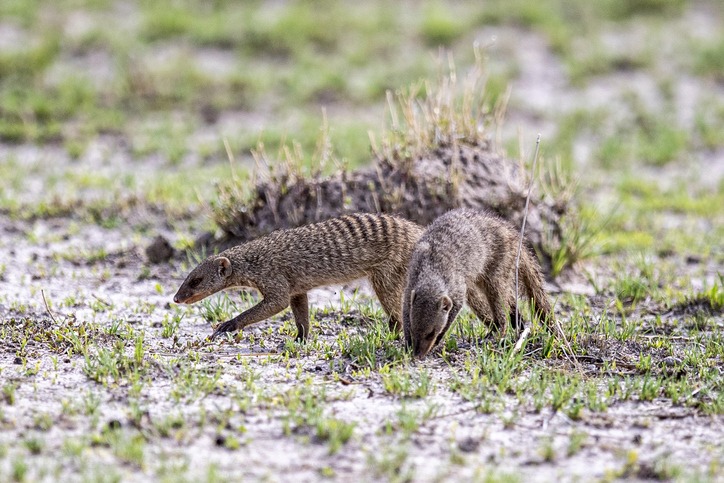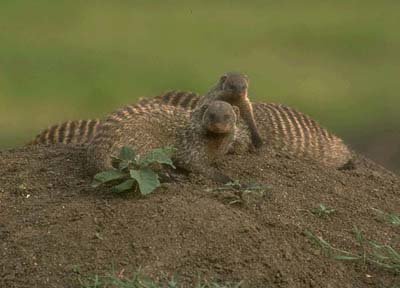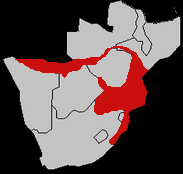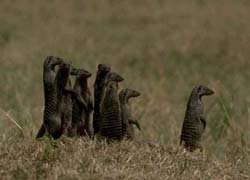The Banded Mongoose is also known for its Latin name Mungos Mungo. These creatures are found in sub-Saharan Africa, and they spend most of their time searching for food. This animal can only reach a length of 30 to 45 cm and a weight of 1.5 to 2.25 kgs. For them to look intimidating to their prey, they live and survive with a large group of their own for their protection. Sometimes, this set-up could also spark a rivalry between other Mongoose clans.
Even though they are considered predators, they can also be considered prey due to their small size—they are even smaller than domestic cats. When a predator approaches banded mongooses, they form together and move as a group, which creates an illusion of a single large animal. The beings in front may even stand on their hind legs and make distinct noises toward the predator.
Its eight levels of scientific classification are as follows:
Kingdom: Animalia
Phylum: Chordata
Class: Mammalia
Order: Carnivora
Suborder: Feliformia
Family: Herpestidae
Genus: Mungos
Species: M. mungo
The physical description of a Banded Mongoose
The Banded Mongoose has a large sturdy head, small ears, short, brawny limbs, and a tail that ranges up to 15 to 30 cm. When it comes to their fur coat, they have coarse, brownish-gray coats, and there are several dark brown to black horizontal lines across the back. These lines differentiate different Mongoose species. Their front feet have long sharp claws, which allow them to scratch and dig in the soil. Their hind feet also have claws, although comparing it to the front feet, these are shorter, heavier, and not as curved. Their abdominal part of the body is increased and in circular form than the breast area. The limbs and snout are darker, though the underparts are lighter than the rest of the body. The nose color of Banded Mongoose differs from gray-brown to orange-red.
The distribution and habitat of Banded Mongoose
The majority of the Banded Mongooses can be found in the significant parts of east, southeast, and south-central Africa. However, there are also recorded populations in the northern savannas of West Africa. They tend to live in savannas, open forests, and grasslands, especially near water. They can also be seen in drylands such as bushland, grasslands, woodlands, and rocky countries. However, Banded Mongooses cannot be seen in the desert or any semi-desert areas. They have a broad habitat and shelter tolerance—they use different types of dens like termite mounds for shelter.
They usually stay in one specific area for a few days to weeks and will often return to their favorite spots. Endowed with sharp claws, they can dig their burrows to use as natural crevices or existing holes created by another animal as shelters.
Ecology of Banded Mongoose
Banded Mongooses are known to be social creatures, especially to their own kind. They live in packs with an average of 10 to 20 individuals but could have as many as 40 individuals. The packs sleep together at night in their underground dens, frequently in termite mounds. They change dens every 2 to 3 days. In a group, there is only one dominant, aggressive male that leads the pack, whereas a female Banded Mongoose is more submissive, but they follow such hierarchy according to their age.
The Banded Mongoose’s behavior, diet, and communication habits
Rivalry and misunderstanding are expected within their packs. Relations between sub-groups within a pack are highly aggressive. Banded Mongooses are sometimes killed and injured during these encounters. However, breeding females tend to mate with males from rival groups during fights. Banded Mongooses mark their territories and communicate with other mongooses through their scent markings.
They are mainly insectivorous. A Banded Mongoose’s diet consists of insects, myriapods, small reptiles, and birds. Though millipedes and beetles make up most of their diet, they also commonly eat ants, crickets, termites, grasshoppers, caterpillars, and earwigs. Their targeted prey are frogs, lizards, ground birds, small snakes, and even eggs. When they encounter hard objects such as eggs or snails, they will either throw the object vertically or backward between its back legs into a sturdy surface or tough stone to break it open. When dealing with frogs or a hairy insect, the Banded Mongoose will roll them around on the ground and pounce at them repeatedly.
WILDLIFE PARKS AND RESERVES WHERE THIS SPECIES IS FOUND:




